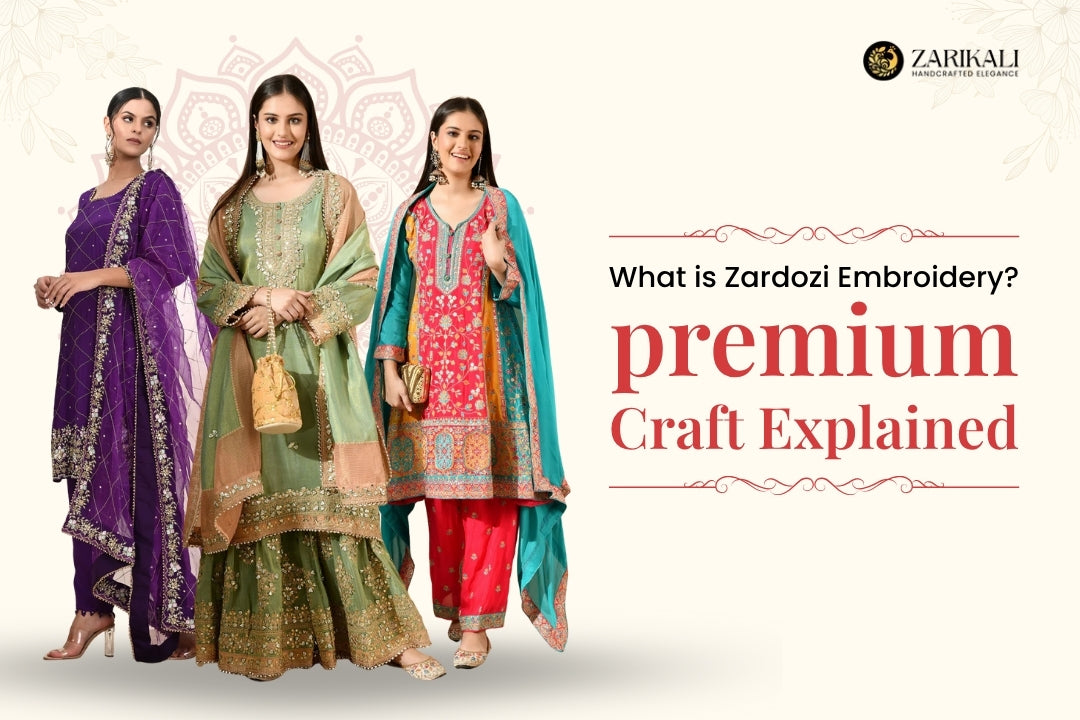
What is Zardozi Embroidery? Premium Craft Explained
Share
Zardozi embroidery is one of India’s most luxurious and intricate crafts. It involves carefully stitching gold, silver, or metallic-coated threads onto fine fabrics to create rich, elaborate designs. Originating in ancient Persia and perfected in India during the Mughal era, Zardozi has become a symbol of regal beauty and cultural heritage.
Today, Zardozi is prized for its artistic detail and traditional charm, found on bridal wear, festive clothing, accessories, and even home décor. This guide explains everything you need to know about Zardozi embroidery - its history, process, materials, types, and tips for buying authentic pieces.
Zardozi Origins & History
The term “Zardozi” comes from Persian: zar means gold, and dozi means embroidery. This craft began in Persia around the 3rd century, used to decorate royal garments, ceremonial robes, wall hangings, and even animal trappings for kings.
Zardozi was brought to India by Persian artisans and reached its peak under Mughal Emperor Akbar in the 16th century. Akbar established royal workshops (karkhanas) where skilled craftsmen created exquisite Zardozi designs for the court. These garments were status symbols, showcasing wealth and refined taste.
However, during British rule, the craft declined due to industrialization and changing tastes. After India’s independence, government initiatives and artisan cooperatives helped revive Zardozi. Today, it is recognized as one of India’s premium crafts, admired globally for its beauty and heritage.
Zardozi vs Zari – What’s the Difference?
Many people confuse Zardozi embroidery with Zari work, but they’re not the same:
-
Zardozi is elaborate, heavy hand embroidery using thicker metallic threads to create raised, dimensional patterns. It often includes pearls, beads, sequins, and stones for added luxury.
-
Zari is a broader term for metallic thread decoration. It can be woven into fabric or used in simpler embroidery, often lighter and sometimes machine-made.
In short: Zardozi is detailed, premium handwork, while Zari can be simpler and machine-produced.
Where is Zardozi Famous in India?
Several cities in India are especially known for their unique Zardozi styles:
-
Lucknow: Famous for fine, detailed work with floral and paisley motifs. A bridal wear favorite.
-
Bhopal: Known for heavier designs with royal Mughal patterns.
-
Delhi (Old Delhi): Home to historic workshops creating luxury garments for designers.
-
Hyderabad: Blends Persian and Indian motifs for a distinctive look.
-
Bareilly: Offers high-quality but more affordable hand-embroidered pieces.
These centers keep the tradition alive while adapting to modern tastes.
The Intricate Process of Zardozi Embroidery
Zardozi’s beauty comes from its highly skilled, time-intensive process:
-
Design Transfer: Patterns are first drawn on tracing paper and then transferred onto fabric with stencils or needles.
-
Frame Setup: The fabric is stretched on a wooden frame (adda) to keep it taut during work.
-
Embroidery Work: Artisans use a fine hooked ari needle to stitch metallic threads along the design lines. Beads, sequins, pearls, or stones may be added for extra detail.
-
Finishing Touches: The finished piece is inspected for neatness, ensuring no loose threads or uneven stitching.
Depending on complexity, a single piece can take days to months to complete.
Materials & Tools Used in Zardozi
What makes Zardozi embroidery so special is its use of premium materials:
-
Metallic Threads: Traditionally real gold and silver threads, but modern versions often use copper coated with gold or silver.
-
Fabrics: Silk, velvet, chiffon, satin, and georgette are chosen for their luxurious finish.
-
Embellishments: Pearls, sequins, beads, glass stones, and even semi-precious gems.
-
Tools: The ari needle allows precise, continuous stitching, while the adda frame ensures fabric tension.
These elements combine to create stunning, durable art that can last generations.
Types of Zardozi Designs
Zardozi isn’t limited to one look—it spans many styles:
-
Traditional Motifs: Floral vines, paisleys, peacocks, and geometric borders, inspired by Mughal art and architecture.
-
Royal Motifs: Designs mimicking palace décor, domes, and courtly patterns.
-
Contemporary Styles: Modern designers blend traditional techniques with abstract or minimalist patterns to appeal to younger audiences.
This adaptability keeps Zardozi relevant for both classic and modern tastes.
Zardozi in Modern Fashion
Zardozi remains popular in today’s fashion world and interior décor:
-
Bridal & Festive Wear: Lehengas, sarees, sherwanis, and gowns with Zardozi embroidery are highly sought after for weddings and celebrations.
-
Luxury Interiors: Embroidered cushion covers, wall hangings, bedspreads, and table runners add opulence to home décor.
-
Accessories: Handbags, clutches, shoes, and belts with Zardozi detailing offer a touch of regal elegance.
Top designers continue to feature Zardozi in their collections, celebrating its heritage while modernizing its appeal.
How to Identify Authentic Zardozi Work
If you want genuine Zardozi embroidery, look for:
-
Evenness & Precision: Authentic pieces have neat, consistent stitching without loose threads.
-
Weight & Texture: Real Zardozi feels heavy and textured because of metallic threads and embellishments.
-
Material Quality: Genuine pieces use high-quality metallic threads, not cheap synthetics.
- Craftsmanship: The reverse side should be tidy and well-finished, showing the artisan’s skill.
Conclusion
Zardozi embroidery is more than just decoration - it's an art form that carries centuries of tradition and royal legacy. By understanding its history, appreciating its craftsmanship, and choosing authentic pieces, you help keep this beautiful craft alive for future generations.
Whether worn on a bridal lehenga or displayed in your home, Zardozi remains a timeless expression of India’s rich cultural heritage.
Discover the charm within Zarikali, where every outfit is crafted to radiate elegance and enchantment.
